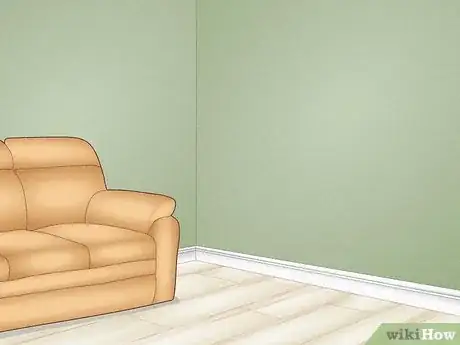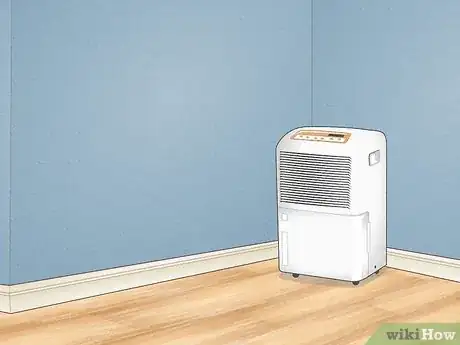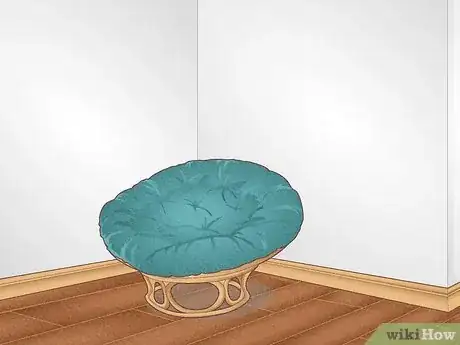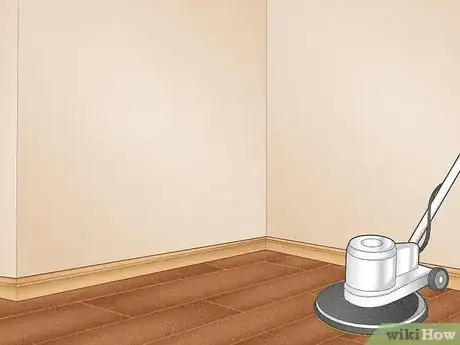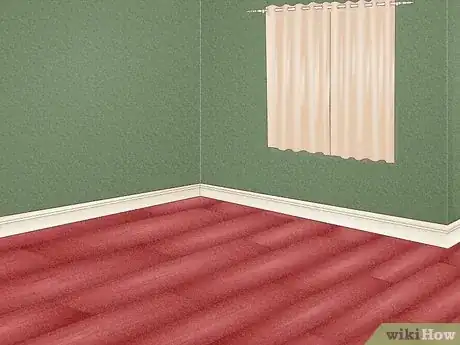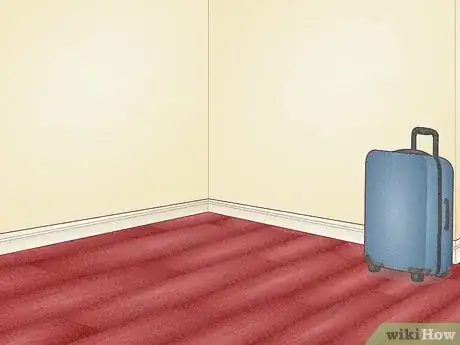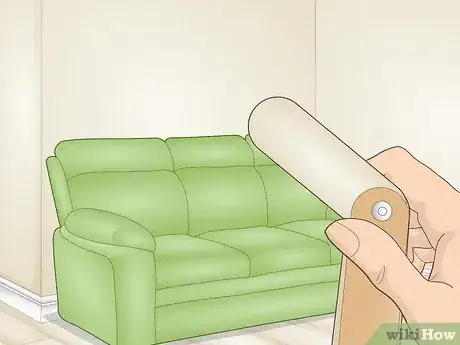This article was co-authored by Kanika Khurana and by wikiHow staff writer, Hunter Rising. Kanika Khurana is an Interior Designer and the Owner of Kanika Design. With over 12 years of experience, Kanika specializes in remodeling, refurnishing, and color consulting. Kanika holds a Bachelor’s Degree in Psychology from San Francisco State University, a Redesign and Home Staging Certification, and an Associate Degree in Business Administration from Cañada College.
There are 12 references cited in this article, which can be found at the bottom of the page.
This article has been viewed 12,628 times.
Your floors and walls take up most of the space in your home, so it makes perfect sense that you want them to match or complement each other. We know you want wood floors and walls to look cohesive, and it's really easy to find the right color combinations that make your room more inviting. We've got everything you need to know about what paint colors work best for different wood floors, so keep reading to find what will look the best in your space!
Things You Should Know
- For light floors, choose light, neutral, or muted wall colors to open the space up. Try a dark wall color for a contrasting look.
- For medium-toned floors, try painting your walls white, neutral colors, or cool pastel shades to brighten up your space.
- For dark wood floors, stick with light colors to prevent the space from feeling small or crowded.
- For cherry floors with red undertones, try neutral colors or complementing colors, like pale green or coral.
Steps
Wall Colors for Light Wood Floors
-
1White or cream Choosing paint in a creamy neutral color is the way to go if you want to make your room feel more spacious. If the room doesn’t have a lot of natural light, try a white or cream with a slight yellow or brown undertone to help make it feel brighter and cozier. Try whites with blue or green undertones to make smaller spaces look more open.[1] X Research source
- Decorator’s White for a slightly warm tone
- Westhighland White for a warmer cream tone
- Pure White for cooler blue undertones
-
2Neutrals Beige, light gray, and tan are all perfect color combinations with light wood floors since they open up your room. Warmer beige tones make the buttery undertones of the hardwood pop, while the cooler tan and grays create a slight contrast that stands out against your floors.[2] X Research source
- Alexandria Beige to work with warm or cool undertones
- Winter Solstice for a gray with cool undertones
- Agreeable Gray for a warm undertone
Advertisement -
3Muted colors The boldest colors may be a little overwhelming against light wood floors, but muted colors still brighten up your space. Try out a soft sage green or a pale slate gray for a cool color palette, or try an inviting warm yellow or a soft glowing orange to give your room a warm and cozy feeling.[3] X Research source
- Sage Wisdom for cool green undertones
- Cavern Clay for warm orange undertones
- Slate Blue for cool blue undertones
-
4Dark blue or charcoal The contrast of your dark walls against a lighter wood floor gives your room a really bold, formal appearance. Dark colors work best if you’re painting a large room with a lot of natural light since it could make small rooms feel a little cramped.[4] X Research source
- Indigo Batik for cool undertones
- Peppercorn for warmer undertones
- Graphic Charcoal for a cool gray undertone
Wall Colors for Medium-Toned Wood Floors
-
1White or neutral gray A bright white or light gray tone on your wall creates a bit of contrast with your floors, so it gives your space a modern, elegant look. Since the colors will be bright against your flooring, your space will really open up.[5] X Research source
- Westhighland White for a warm cream tone
- Agreeable Gray for a slightly warm undertone
- Alabaster for cool or warm undertones
-
2Warm yellows If you want your room to feel more inviting, try using a soft yellow color. Yellows also make a smoother transition between your wood floors and walls so your space looks more cohesive.[6] X Research source
- Hawthorne Yellow for warm undertones
- Fun Yellow for warmer undertones
- Lighthouse Landing for cool or warm undertones
-
3Pastels Pastels give your room a pop of brightness that flows well with your wood floors. Lilac, sky blue, mint green, and blue-gray are all cool pastel tones that look great when you pair them with natural or golden floor colors.[7] X Research source
- Inspired Lilac for cooler purple undertones
- Icy Mint for cool green undertones
- Gentle Gray for a warm undertone
-
4Cool blues and greens Medium-toned hardwoods like walnut are really versatile, so they can pair well with the cool tones of dark paint color. Blue and green are also great if you want to choose a relaxing color scheme for a bedroom or living room since they can help you feel more comfortable and at ease.[8] X Trustworthy Source American Psychological Association Leading scientific and professional organization of licensed psychologists Go to source
- Aleutian for a pale blue undertone
- Spring Mint for a cool green with blue undertones
- Liberty Park for a warm, earthy green undertone
Wall Colors for Dark Wood Floors
-
1White or cream The contrast between the dark hardwoods and the light paint on your walls will give your room a striking look that completely opens the space up. In a large room, white and cream walls create an elegant, clean appearance that’s sure to stand out.[9] X Research source
- Decorator’s White for a bright, slightly warm undertone
- Agreeable Gray for warm neutral shades
- Alabaster to pair with cool or warm undertones
-
2Pastels If you want to give your room a pop of color, stick to muted pastel tones rather than really intense, vibrant shades. Pale blues, greens, oranges, and yellows help make the room feel open.[10] X Research source
- Faraway Blue for pale cool undertones
- Hawthorne Yellow for a warm, sunny undertone
- Inner Peach for a warm and cool light pink undertone
-
3Dark blue or gray While dark walls against dark floors can make a space feel closed off, it can also give a room a really modern, formal twist. If you go this route, just be sure to have some light-colored furniture to break up the space.[11] X Research source
- Mysterious for a cool gray undertone
- Victory Blue for a deep cool blue tone
- Slate Tile for a slightly warmer undertone
Wall Colors for Cherry Hardwood Floors
-
1Neutrals The natural red hue of cherry wood makes them the star of your room, so stick to neutral colors so you don’t overwhelm the space. Simple whites, grays, beiges, and creams are great choices since they’ll let your floor be the center of attention.[12] X Research source
- Chantilly Lace to pair with any undertone
- Pashmina for a simple warm cream undertone
- Swiss Coffee for slight warm yellow undertones
-
2Cool blues and greens Blues and greens are perfect for complementing the red undertones of your cherry floor. Stick to colors that are more muted rather than bright, vibrant shades so you don’t accidentally create a clashing color scheme.[13] X Research source
- Greenfield for a cool green tone
- Misty for blue with hints of green undertone
- Stargazer for a slightly warmer tone
-
3Pale yellows and corals Yellows and pink corals pick up on all of the undertones in cherry wood to really warm your space up. Since the colors are pretty similar, they’ll make a smooth transition between your walls and floors.[14] X Research source
- Pale Coral with warm and cool undertones
- Pineapple Cream with a warm, yellow undertone
- Firefly to enhance the pale yellow tones
Tips for Choosing Paint Colors
-
1Pick paint colors that complement the wood undertones. Wood floors with warm undertones usually look red, orange, yellow, or brown, while flooring with cool undertones appears blue, purple, or gray. If you like a high-contrast style, then choose wall colors that contrast the undertones of your floors. If you want a more cohesive-looking space, use colors that have similar tones.[15] X Research source
- Example: For floors with blue undertones, you can try matching with blue, green, or purple paints. For a contrasting style, try orange or yellow paint to make a statement.
- Example: For floors with a yellow honey undertone, use complementary colors like orange or red to maintain the warm undertones.
- As a general rule of thumb, try to get paint that’s about 3 shades lighter than your floors, but don’t be afraid to play around with contrasting colors.
-
2Check that the wall color works with your furniture. Try to pull potential wall colors from your furniture and decor so it’s easier to choose a color palette that works well in your space. Before you paint any colors on your walls, hold the swatches up to your furniture so you can see if the colors complement one another or if they clash.[16] X Research source
- Example: If you have a light green couch, you may choose a more neutral wall color so the colors aren’t competing.
- Example: If you have a dark wood table or shelving, stick with a lighter wall color to brighten up the space.
-
3Test colors before painting your entire wall. Get swatches from your local paint store and hold them against your wall so you can get used to how the color works. If you want to get a better idea of how the color looks in your space, buy a sample of the color. Then, paint a 2 ft × 2 ft (61 cm × 61 cm) section of your wall with the color. Apply 2 coats of paint to get the most accurate color.[17] X Research source
- Some paint stores have larger swatches that stick onto the wall that are easier to see than the standard size.
You Might Also Like

 How to Get Spray Foam off Your Hands
How to Get Spray Foam off Your Hands






 How to Defrost a Samsung Ice Maker: A Quick Guide
How to Defrost a Samsung Ice Maker: A Quick Guide



References
- ↑ https://www.thisoldhouse.com/painting/21015206/how-to-choose-the-right-colors-for-your-rooms
- ↑ https://www.bhg.com/decorating/color/paint/paint-colors-that-flatter-yellow-wood-tones/
- ↑ https://roomdsign.com/article/best-wall-colors-for-light-wood-floors/
- ↑ https://www.bhg.com/decorating/color/paint/paint-colors-that-flatter-yellow-wood-tones/
- ↑ https://youtu.be/Cy936fUhY2M?t=346
- ↑ https://www.bhg.com/decorating/color/basics/color-and-wood-tone/
- ↑ https://www.bhg.com/decorating/color/paint/paint-colors-that-flatter-yellow-wood-tones/
- ↑ https://www.apa.org/monitor/apr01/greengood
- ↑ https://youtu.be/4wauWdZwqA8?t=232
- ↑ https://www.bhg.com/decorating/color/basics/color-and-wood-tone/
- ↑ https://youtu.be/4wauWdZwqA8?t=56
- ↑ https://youtu.be/m5RTqFPByY4?t=334
- ↑ https://roomdsign.com/article/what-color-wall-goes-with-cherry-wood-floors/
- ↑ https://roomdsign.com/article/what-color-wall-goes-with-cherry-wood-floors/
- ↑ https://www.bhg.com/decorating/color/basics/color-and-wood-tone/
- ↑ https://www.thisoldhouse.com/painting/21015206/how-to-choose-the-right-colors-for-your-rooms
- ↑ https://youtu.be/qMNYOmHa_3c?t=35
About This Article



